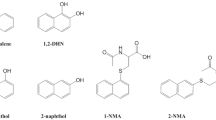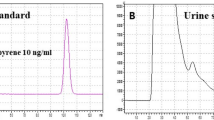Abstract
Background
1, 3-Butadiene is an important industrial compound. Based on sufficient evidence of carcinogenicity in laboratory animals and humans, the International Agency for Research on Cancer, in 1999, classified 1, 3-Butadiene as a probable carcinogen to humans (group 2A). The potential for exposure to vehicle exhaust containing these chemical compounds is very noticeable in urban locations. Exposure to incomplete combustion of gasoline has been a long time concern in many occupational fields, including policemen, service stations, and the petroleum industry but in Iran has rarely been studied.
Methods
This study designed to determine the exposure levels for traffic policemen and gas station workers during routine work shift, by biological monitoring. With this aim, 25 policemen engaged in traffic control, 25 gas station workers and 25 occupationally non-exposed persons were investigated. Spot urine samples were obtained prior to and at the end of the work shift from each subject. The urinary levels of selected urinary metabolites (MHBMA and DHBMA) were determined by using LC–MS/MS.
Results
There were significant differences among the mean urinary concentrations of DHBMA in pre-shift samples of policemen, gas station workers and occupationally non-exposed persons. The mean urinary concentrations of DHBMA differed significantly among post-shift samples of policemen and gas station (ANOVA: p < 0.05 and Kruskal-Wallis test: p < 0.05).
Conclusions
There was a significant difference in DHBMA concentrations between job categories (p < 0.05 by ANOVA and Kruskal-Wallis test), and policemen and gas station workers were found to be probably the most exposed groups in this study.
Similar content being viewed by others
Data availability
The data will not be shared with a reason.
Abbreviations
- IARC:
-
International Agency for Research on Cancer
- MHBMA:
-
Monohydroxybutenyl-mercapturic acid
- DHBMA:
-
Dihydroxy-butyl-mercapturic acid
- SPE:
-
Solid phase extraction
- TWA:
-
Time weight average
References
Huff J, et al. Multiple organ carcinogenicity of 1, 3-butadiene in B6C3F1 mice after 60 weeks of inhalation exposure. Science. 1985;227(4686):548–9.
Program NT. NTP toxicology and carcinogenesis studies of 1, 3-butadiene (CAS No. 106-99-0) in01 0B6C3F1 mice (inhalation studies). Natl Toxicol Program Tech Rep Ser. 1993;434:1.
Humans IW.G.o.t.E.o.C.R.t. and I.A.f.R.o. Cancer, Some chemicals that cause tumours of the kidney or urinary bladder in rodents and some other substances. 1999: International Agency for Research on Cancer.
Sielken RL Jr, et al. Cancer risk assessment for 1, 3-butadiene: Dose–response modeling from an epidemiological perspective. Chemico-Biol Interact. 2007;166(1–3):140–9.
Phillimore P, Reading R. A rural advantage? Urban—rural health differences in Northern England. J Public Health. 1992;14(3):290–9.
Polednak AP. RE:“Relation Between Population Density And CancerIncidence, Illinois, 1986–1990”. Am J Epidemiol. 1994;139(7):741–2.
Filippini T, et al. Association between outdoor air pollution and childhood leukemia: a systematic review and dose–response meta-analysis. Environ Health Perspect. 2019;127(4):046002.
Hakkola M, Saarinen L, Pekari K. Exposure to gasoline vapour during offloading of tankers and railway wagons and biological multicomponent monitoring. J Occup Health. 2001;43(5):287–90.
Scibetta L, et al. Urinary MTBE as biological marker of exposure to traffic exhaust fumes. Giornale Italiano di Medicina del Lavoro ed Ergonomia. 2005;27(3):315–7.
Urban M, et al. Determination of the major mercapturic acids of 1, 3-butadiene in human and rat urine using liquid chromatography with tandem mass spectrometry. J Chromatogr B. 2003;796(1):131–40.
Eckert E, et al. Mercapturic acids as metabolites of alkylating substances in urine samples of German inhabitants. Int J Hyg Environ Health. 2011;214(3):196–204.
Carrieri M, et al. Validation of a radial diffusive sampler for measuring occupational exposure to 1, 3-butadiene. J Chromatogr A. 2014;1353:114–20.
Sakurai K, Miyake Y, Amagai T. Reliable passive-sampling method for determining outdoor 1, 3-butadiene concentrations in air. Atmos Environ. 2013;80:198–203.
Li W, et al. Sensitive determination of two major mercapturic acid metabolites of 1, 3-butadiene in human urine based on the isotope dilution ultrahigh performance liquid chromatography-tandem mass spectrometry. Anal Methods. 2015;7(11):4691–8.
Schenk L, et al. Occupational exposure limits: A comparative study. Regul Toxicol Pharmacol. 2008;50(2):261–70.
Barsan ME. NIOSH pocket guide to chemical hazards. 2007.
Sapkota A, et al. Urinary biomarkers of 1, 3-butadiene in environmental settings using liquid chromatography isotope dilution tandem mass spectrometry. Chemico-Biol Interact. 2006;160(1):70–9.
Fustinoni S, et al. Biological monitoring in occupational exposure to low levels of 1, 3-butadiene. Toxicol Lett. 2004;149(1–3):353–60.
Albertini R, et al. Biomarkers in Czech workers exposed to 1, 3-butadiene: a transitional epidemiologic study. Res Rep (Health Effects Institute), 2003(116):1.
Boogaard PJ, van Sittert NJ, Megens HJ. Urinary metabolites and haemoglobin adducts as biomarkers of exposure to 1, 3-butadiene: a basis for 1, 3-butadiene cancer risk assessment. Chem Biol Interact. 2001;135:695–701.
Acknowledgements
This study was supported by National Institute for Medical Research Development (Grant No. 965455) and Iranian National Science Foundation (INSF) under Grant 96010139. Hereby, the cooperation of the University and also the Institute for Environmental Research (IER) is highly appreciated.
Funding
This study was supported by National Institute for Medical Research Development (Grant No. 965455) and Iranian National Science Foundation (INSF) under Grant 96010139. Hereby, the cooperation of the University and also the Institute for Environmental Research (IER) is highly appreciated.
Author information
Authors and Affiliations
Contributions
RA and NR participated in the design of the study. RA did the analyses and MGH interpreted the analyzed results. NR was the main investigator, supervised the work, drafted and revised the paper critically for important intellectual content and compiled the work in accordance to journal format. All authors have read and approved the final manuscript.
Corresponding author
Ethics declarations
Declaration
Not applicable.
Ethics approval and consent to participate
The research protocol was approved by Ethics Committee of Tehran University of Medical Sciences (IR.TUMS.SPH.REC.1396.2335).
Consent for publication
Not applicable.
Conflict of interest
The authors declare that they have no competing interests.
Additional information
Publisher’s note
Springer Nature remains neutral with regard to jurisdictional claims in published maps and institutional affiliations.
Rights and permissions
About this article
Cite this article
Ahmadkhaniha, R., Ghoochani, M. & Rastkari, N. Application of biological monitoring for exposure assessment of 1.3 Butadiene. J Environ Health Sci Engineer 18, 1265–1269 (2020). https://doi.org/10.1007/s40201-020-00544-2
Received:
Revised:
Accepted:
Published:
Issue Date:
DOI: https://doi.org/10.1007/s40201-020-00544-2




